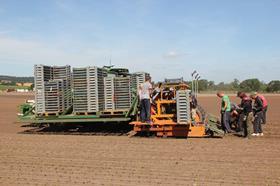
A seasonal workers scheme could be allowed after Brexit to avoid the “contraction and even closure” of agricultural businesses, a long-awaited government report on migration has recommended.
The document published by the Migration Advisory Committee (MAC) said a reincarnated SAWS scheme could be the only work migration scheme that is permitted for lower-skilled workers after Brexit
The MAC report stressed that the labour market for seasonal agricultural labour is separate from the market for resident workers “in a way that is unlike any other labour market”.
According to ONS statistics, 99 per cent of seasonal agricultural workers are from other EU countries, with the report saying it is “difficult to imagine a scenario in which this workforce can come from the resident labour market”.
Despite this, the MAC report said there were both advantages and disadvantages to introducing a post-Brexit SAWS scheme. It noted that although the failure to adopt a scheme was likely to lead to the contraction and closure of many businesses in the short term, this “should not be seen as catastrophic for the economy as a whole” since agriculture is “a small, low-wage, low-productivity sector” in the wider UK context”.
The report did point out, however, that this may lead to “modestly higher prices” for consumers in certain horticultural products.
It was recommended that growers be encouraged to pay a higher minimum wage in return for the sector’s “privileged access to labour”, but the MAC said it was important that the current pilot SAWS scheme does not allow the agricultural sector to access low-skilled migrant labour on a permanent basis.
The government has said it would consider the MAC report’s findings when setting its post-Brexit immigration strategy, however there are still no concrete plans to reintroduce a permanent scheme for seasonal agricultural workers.
A pilot scheme was announced in early September, following a lengthy Defra enquiry, with the government committing to allocate six-monthvisas to 2,500 workers from non-EU countries.
Although this came as welcome news to the agricultural sector after months of pressure for the government to give commitments on labour supply, the scheme only scratches the surface of what is required to deal with growing labour shortages.
The NFU estimates that 60,000 seasonal workers are employed in the UK horticulture industry every year, and with freedom of movement far from guaranteed after Brexit, it is unclear whether seasonal workers from within the EU will be allowed to return in future.
Soil Association policy officer Sam Packer said he welcomed the report but stressed that the industry was already struggling to find enough candidates, with businessesfacing a labour shortfall of up to 29 per cent during last year’s harvest.
“The government must therefore commit to maintaining the supply of seasonal migrant labour to agriculture outside of the EU,” he said.
Chief executive for the Food and Drink Federation Ian Wrightadded that the proposals failed to ensure the industry would continue to have access to EU workers across the full range of skill levels.
“Any new system that constricts and constrains businesses’ ability to grow or to deal with changing consumer demand will do nothing to improve wage growth and may increase the cost of food and drink in the long-term,” he said.
“It is essential that government prioritises migration in EU negotiations to ensure UK food and drink manufacturers have access to the employees they need at all skill levels.”
Meanwhile, CLA president Tim Breitmeyersaid that while hewelcomed recognition of the importance of a seasonal workers scheme, the report failed to recognise that the need for seasonal labour in the rural economy extends far beyond farming.
“Tourism and the agri-food industry require a constant supply of multi-skilled labour,” he said. “Putting a stop to this pipeline will jeopardise the future viability of many rural businesses and encourage the moving of production offshore.”



